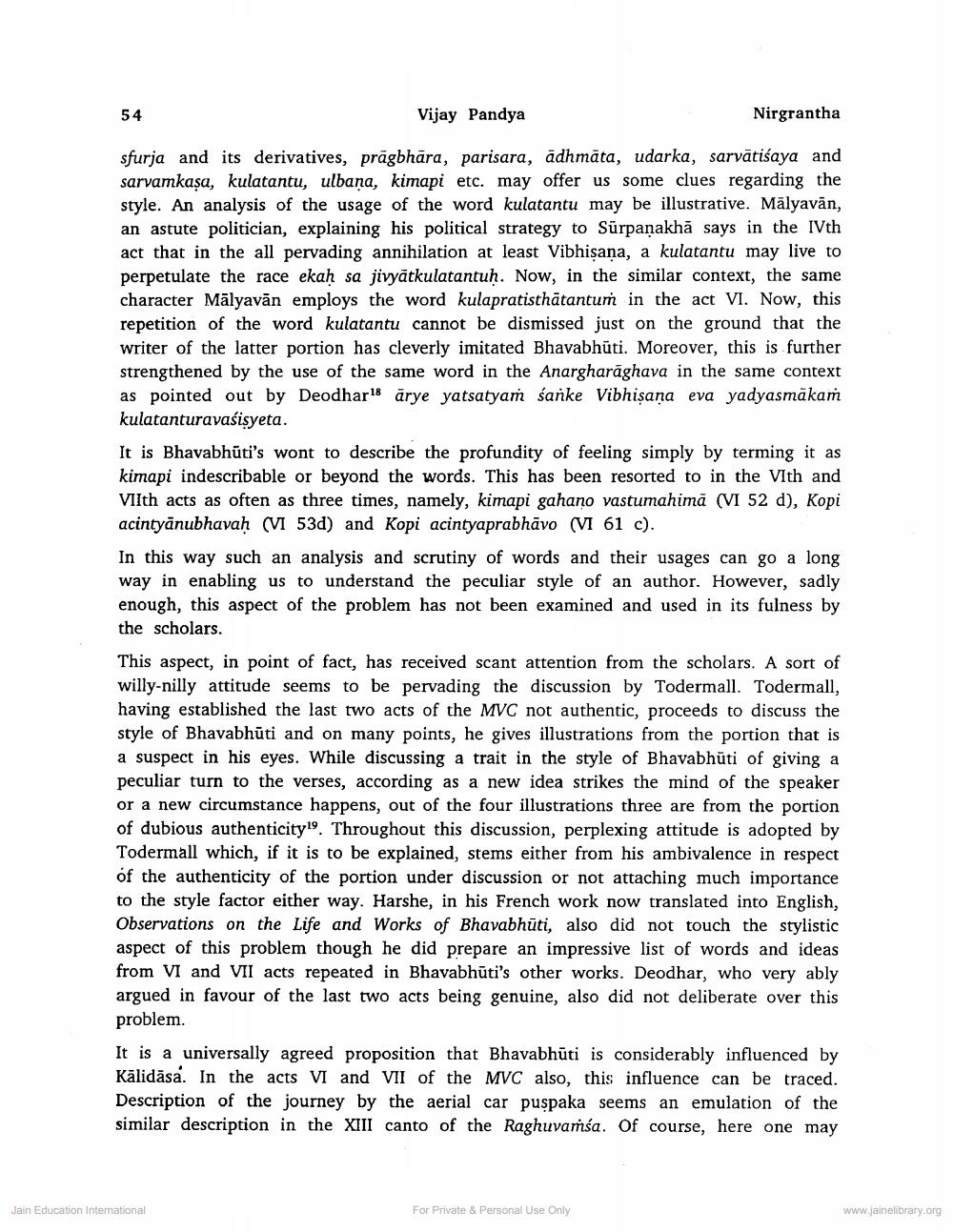________________
54
Vijay Pandya
Nirgrantha
sfurja and its derivatives, prāgbhāra, parisara, ādhmāta, udarka, sarvātiśaya and sarvamkașa, kulatantu, ulbana, kimapi etc. may offer us some clues regarding the style. An analysis of the usage of the word kulatantu may be illustrative. Mālyavān, an astute politician, explaining his political strategy to Sürpanakhă says in the IVth act that in the all pervading annihilation at least Vibhișana, a kulatantu may live to perpetulate the race ekah sa jivyātkulatantuh. Now, in the similar context, the same character Mālyavān employs the word kulapratisthātantum in the act VI. Now, this repetition of the word kulatantu cannot be dismissed just on the ground that the writer of the latter portion has cleverly imitated Bhavabhūti. Moreover, this is further strengthened by the use of the same word in the Anargharāghava in the same context as pointed out by Deodhar 18 arye yatsatyam sanke Vibhisana eva yadyasmākam kulatanturavašisyeta. It is Bhavabhūti's wont to describe the profundity of feeling simply by terming it as kimapi indescribable or beyond the words. This has been resorted to in the Vith and VIIth acts as often as three times, namely, kimapi gahano vastumahimā (VI 52 d), Kopi acintyānubhavaḥ (VI 53d) and Kopi acintyaprabhāvo (VI 61 c). In this way such an analysis and scrutiny of words and their usages can go a long way in enabling us to understand the peculiar style of an author. However, sadly enough, this aspect of the problem has not been examined and used in its fulness by the scholars. This aspect, in point of fact, has received scant attention from the scholars. A sort of willy-nilly attitude seems to be pervading the discussion by Todermall. Todermall, having established the last two acts of the MVC not authentic, proceeds to discuss the style of Bhavabhūti and on many points, he gives illustrations from the portion that is a suspect in his eyes. While discussing a trait in the style of Bhavabhūti of giving a peculiar turn to the verses, according as a new idea strikes the mind of the speaker or a new circumstance happens, out of the four illustrations three are from the portion of dubious authenticity. Throughout this discussion, perplexing attitude is adopted by Todermall which, if it is to be explained, stems either from his ambivalence in respect of the authenticity of the portion under discussion or not attaching much importance to the style factor either way. Harshe, in his French work now translated into English, Observations on the Life and Works of Bhavabhūti, also did not touch the stylistic aspect of this problem though he did prepare an impressive list of words and ideas from VI and VII acts repeated in Bhavabhūti's other works. Deodhar, who very ably argued in favour of the last two acts being genuine, also did not deliberate over this problem. It is a universally agreed proposition that Bhavabhūti is considerably influenced by Kālidāsa. In the acts VI and VII of the MVC also, this influence can be traced. Description of the journey by the aerial car puspaka seems an emulation of the similar description in the XIII canto of the Raghuvaṁsa. Of course, here one may
Jain Education Intemational
For Private & Personal Use Only
www.jainelibrary.org




